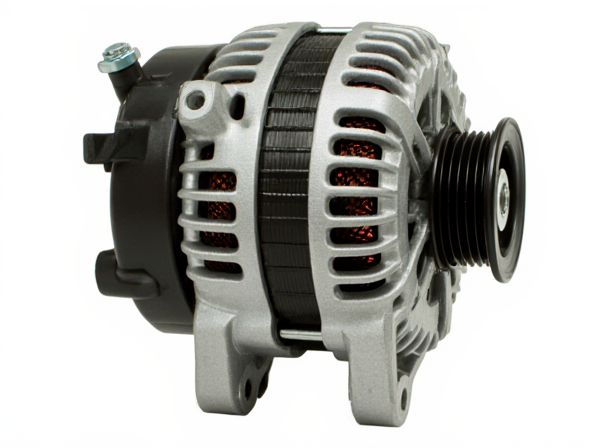
Photo illustration: Dual-Output vs Single-Output Alternator
Dual-output alternators provide both high and low voltage outputs, enhancing compatibility with various electrical systems and improving overall efficiency. Single-output alternators supply power on a single voltage line, which may limit their flexibility in complex applications. Your choice depends on the specific power needs and system requirements of your vehicle or equipment.
Table of Comparison
| Feature | Dual-Output Alternator | Single-Output Alternator |
|---|---|---|
| Power Output | Higher total amperage and wattage; supports multiple battery systems | Standard amperage; designed for single battery systems |
| Voltage Regulation | Independent regulation for each output for stable performance | Single voltage regulation only |
| Application | Ideal for vehicles with dual battery setups or high electrical demands | Suitable for standard vehicles with normal power requirements |
| Cost | Higher cost due to complex design | Lower cost, simpler technology |
| Reliability | Enhanced reliability with backup output option | Reliable but limited to single output supply |
| Weight & Size | Typically larger and heavier | Compact and lightweight |
| Installation | More complex installation process | Simple installation |
Introduction to Alternator Output Types
Dual-output alternators generate power through two separate voltage outputs, enabling simultaneous support for multiple electrical systems in vehicles or machines. Single-output alternators produce one combined voltage output, simplifying design but limiting the ability to independently manage different voltage needs. Choosing between these alternator output types depends on the complexity of the electrical system and specific power distribution requirements.
What is a Single-Output Alternator?
A single-output alternator generates electrical power through one main output terminal, providing a consistent voltage supply primarily used to charge a vehicle's battery and power its electrical system. It is designed for simpler electrical setups where power demand is moderate and centralized. Compared to dual-output alternators, single-output units have fewer components, which often translates into lower cost and easier maintenance.
Understanding Dual-Output Alternators
Dual-output alternators generate two separate voltage outputs, typically one for charging the battery and another for powering accessories, enhancing electrical system efficiency in vehicles. This design ensures stable power delivery to critical systems without overloading the primary battery circuit, improving overall reliability and lifespan. Compared to single-output alternators, dual-output models provide better voltage regulation and distribute electrical loads more effectively, making them ideal for modern vehicles with complex electrical demands.
Key Differences Between Dual and Single-Output Alternators
Dual-output alternators provide two separate voltage outputs, enhancing versatility for powering multiple systems or devices simultaneously, while single-output alternators generate only one voltage output for standard applications. Dual-output models improve electrical system efficiency by offering dedicated power supplies, reducing electrical load strain and minimizing voltage drops. Single-output alternators are simpler, lighter, and typically more cost-effective, making them suitable for basic automotive or light industrial use.
Performance and Efficiency Comparison
Dual-output alternators provide separate voltage outputs optimized for different electrical systems, enhancing overall vehicle performance and efficiency by reducing energy loss and improving power distribution. Single-output alternators deliver a uniform voltage output, often leading to inefficiencies when powering diverse components with varying voltage requirements. The dual-output design increases alternator efficiency by tailoring power delivery, resulting in better fuel economy and prolonged battery life compared to single-output models.
Applications for Dual-Output Alternators
Dual-output alternators are ideal for vehicles requiring separate electrical circuits with different voltage demands, such as emergency vehicles with auxiliary lighting and communication systems. These alternators efficiently supply power to both the main battery and auxiliary batteries, ensuring consistent performance and preventing electrical overload. Their application in recreational vehicles and boats supports extended use of high-powered accessories without compromising engine performance.
Applications for Single-Output Alternators
Single-output alternators are widely used in standard automotive applications, providing reliable power supply for essential electrical systems such as lighting, ignition, and battery charging. Their simpler design ensures cost-effectiveness and ease of maintenance for everyday vehicles and small machinery. These alternators are ideal for applications where a single voltage output meets all operational requirements efficiently.
Pros and Cons of Dual-Output Alternators
Dual-output alternators provide two separate voltage outputs, enhancing electrical system flexibility by allowing independent power supply to different circuits, which reduces load on each output. They excel in applications requiring multiple voltage levels or isolated systems but tend to be more complex and costly than single-output alternators. Maintenance can be more challenging due to increased components, yet their dual-output feature improves reliability in boats, RVs, and industrial equipment by preventing total power failure.
Pros and Cons of Single-Output Alternators
Single-output alternators feature a simplified design, making them more cost-effective and easier to maintain compared to dual-output alternators. However, their limitation lies in providing power from only one output, which may restrict flexibility in applications requiring multiple voltage sources or independent circuits. This constraint can lead to inefficiencies in complex electrical systems where dual-output alternators would better support simultaneous power demands.
Choosing the Right Alternator for Your Needs
Choosing the right alternator depends on your electrical system requirements and power demands. Dual-output alternators offer higher current capacity and the ability to charge multiple batteries or different voltage systems simultaneously, making them ideal for complex vehicle setups or heavy-duty applications. Single-output alternators provide a simpler, cost-effective solution for standard automotive use where only one battery needs charging and moderate power output suffices.
 caratoz.com
caratoz.com